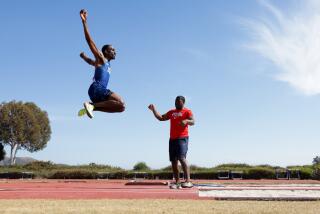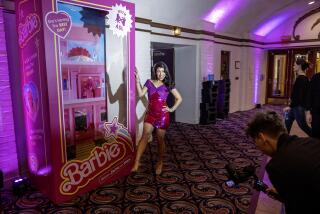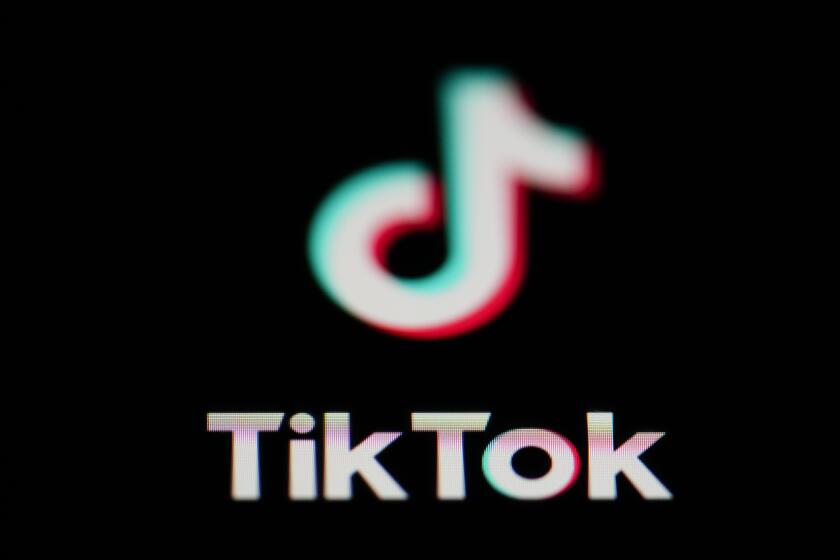Enabling a High-Tech Connection
- Share via
For years, Ramy Bustamante couldn’t communicate with his employees or family when he was on the road. Pay phones were off-limits. Mobile phones were no better.
That changed in the spring, when Bustamante, who is deaf, bought a pager that works with the text telephones, known as TTYs, used by his wife and his staff.
“I was out of the office when my wife got sick and paged me so I could come home immediately and watch the baby and my 3-year-old son,” said Bustamante, who operates a clearinghouse for American Sign Language information on the Internet.
Millions of Americans such as Bustamante have yet to find solutions that will allow them to communicate in ways most people take for granted. For the disabled, telecom products such as mobile phones and pagers and services such as automated menus and voicemail remain inaccessible.
But federal rules designed to give people with disabilities access to a range of telecom products and services are expected to bring about a fundamental shift in the way companies make these systems and how they are used.
“We’re hoping this will do what curb cuts did for physical mobility,” said Jacquelyn Brand, founder of the Alliance for Technology Access. “Instead of this being an accommodation for a small niche of people, it became the preferred way to design a street corner for people pushing strollers or riding skateboards or rolling in wheelchairs.”
About 54 million Americans have disabilities ranging from vision and hearing problems to mobility and cognitive difficulties. That number is expected to mushroom when the nation’s 76 million baby boomers retire in the next two decades.
“I was at a conference talking to a woman with a disability, and she said, ‘I should be thankful I was doing this because I am TAB--or temporarily able-bodied,’ ” said FCC Chairman William E. Kennard. “Statistics show if we live to be 75 years old, 72% of us will have some disability.”
About half of people older than 75 who have a disability suffer a severe loss in hearing or vision. The rest lose a portion of their hearing or vision or have some loss of motor skills and cognitive functions, researchers say.
Last month, the FCC unveiled rules aimed at helping manufacturers comply with a section of the Telecommunications Act that requires companies to make all their products, not just one or two models, accessible to the disabled. The agency included a list of recommended functions for each new device or service that would make it accessible for people with limited vision, hearing, speech, color perception, manual dexterity and cognitive skills.
The FCC will rely in part on complaints from consumers to monitor manufacturers’ progress. Companies that can prove it would be too costly or technically difficult to make a product accessible could be exempted.
Until recently, manufacturers made few products accessible to the disabled, claiming they didn’t have the resources to pay for changes. The devices that were available usually cost more than similar products.
But today, companies have a regulatory and an economic incentive to take action.
As a result of the federal mandate, manufacturers may provide big buttons on phones for the blind, phones with volume control for the deaf, talking caller ID for those who can’t see or move quickly, and phones with headsets for people who can’t hold the receiver, Kennard said.
Most products today are designed to help the deaf and hard of hearing. But the University of Wisconsin’s Trace Research and Development Center has come up with a mobile phone for people with a range of disabilities.
The center is working with several manufacturers on a “universal design” for a mobile phone that would incorporate such features as volume control, voice activation, TTY compatibility and speakerphone.
“We could put all of these features in every phone in a year or two and take up a little corner of a phone’s program space,” said Gregg Vanderheiden, a professor of industrial engineering and human factors at the university and director of the Trace Center. “The biggest cost is learning how to do it the first time. But within five years, the cost to add access to phones will be less than the cost of the cardboard box they’re shipped in.”
Several products designed with the disabled in mind--such as vibrating pagers, pay phones with volume-control buttons and speakerphones--are already on the market.
One such device is an attachment from Nokia that makes hearing aids compatible with several of its digital mobile phones. A high-frequency electromagnetic signal emitted by digital mobile phones causes a buzz in hearing aids. Nokia’s Loopset, which attaches to the bottom of the phone and loops around the user’s neck, sucks in this magnetic energy by shutting off the hearing aid’s microphone. It converts these impulses to sound and eliminates background noise.
For the most part, digital mobile phones remain inaccessible to the deaf and hard of hearing because they aren’t compatible with text telephones. To deal with the problem, Lucent Technologies has developed software that makes changes to both the digital handset and the network, allowing each to read and transmit tones emitted by a TTY. But these phones aren’t likely to hit the market for several years.
For now, the deaf and hard of hearing must use relay centers created by the Baby Bells in the 1990s. These centers enable them to make calls by dialing a toll-free number and typing in the number of the party they want to reach.
When callers type in a message using a TTY, the text travels over the phone network and appears on a computer screen at the relay center. The operator then reads the message to the party being called.
Problems arise when the operator must input the reply from the TTY recipient. That’s because operators can transcribe an average of about 40 of the 150 words people speak per minute, said Pam Holmes, director of consumer and regulatory affairs for Ultratec, a Madison, Wis.-based firm that develops products for the deaf and hard of hearing. Often the transcribed conversation is full of spelling errors and sentences taken out of context, she said.
Ultratec announced that it will join with Sprint next month in testing a speech-recognition system that allows operators to train a computer to understand their voice. Operators would then speak to the computer, which can transmit up to 200 words a minute back to the TTY user. Speech-recognition software is robust enough today to memorize and replicate a single voice--in this case, the operator’s--but would have difficulty transcribing the voice of each caller, Holmes said.
But any changes in communications products for the disabled will require more than shifts in the design process.
“There have been wireless companies that tried to market a hearing service to the deaf community just with a new brochure,” said Dan Luis, president and chief executive of Wynd Communications, a San Luis Obispo company that provides the wireless pager service used by entrepreneur Bustamante. “That type of stuff gets rejected flat out because those companies don’t have the resources to support that customer.”
To ensure that his employees understood the needs of the deaf and hard of hearing, Luis required them to learn sign language and hired several executives who are hearing-impaired. Wynd’s service, which Luis refers to as “wireless TTY,” allows users to send TTY messages over BellSouth’s wireless network to a pager.
Baltimore, Md.-based Reachnet also uses BellSouth’s network. Like Wynd, its service allows a customer to carry on a live conversation from a pager to a TTY device or a pager to a relay service.
Wynd’s customers rank the system with TTYs and closed captioning among the three most important advances in making technologies most people take for granted accessible to the disabled.
“Now I can look at people who use cell phones and feel quite contented,” said Herb Larson of Northridge, who got a Wynd pager as a retirement present from his daughters. “I’m not really that different when I’m trying to get help in an emergency.”
*
Times staff writer Jennifer Oldham can be reached a [email protected].
(BEGIN TEXT OF INFOBOX / INFOGRAPHIC)
Universal Access
University of Wisconsin researchers have developed a mobile phone that will be accessible to almost everyone. Using what’s known as a “universal design,” the engineers combined on one handset the features that are available separately on today’s mobile phones. They are now working with several manufacturers to develop the device. The features are designed to help those with a range of disabilities, such as difficulty in hearing, moving or seeing:
Headset jack: Would allow connection with hearing aid accessories and TTY (teletypewriters).
Infrared port: Would allow wireless communication to TTYs and other devices.
Volume control and speakerphone capability: Would help those with mobility problems.
Oversize matrix display: Would allow easier reading of graphical and text messages.
Easy-to-feel keys: Small dots on the “5” key and the dish shape of the keys make for easier dialing. A user can dial by typing or voicing a name. Keypad can be used to type messages.
EZ button: Would allow users to have any key’s function or the messages onscreen read back to them.
Connector: Would allow easier linking of a keyboard or other devices by touch.
Sources: Times research, Trace Research & Development Center at University of Wisconsin
Researched by JENNIFER OLDHAM / Los Angeles Times
More to Read
Sign up for Essential California
The most important California stories and recommendations in your inbox every morning.
You may occasionally receive promotional content from the Los Angeles Times.










